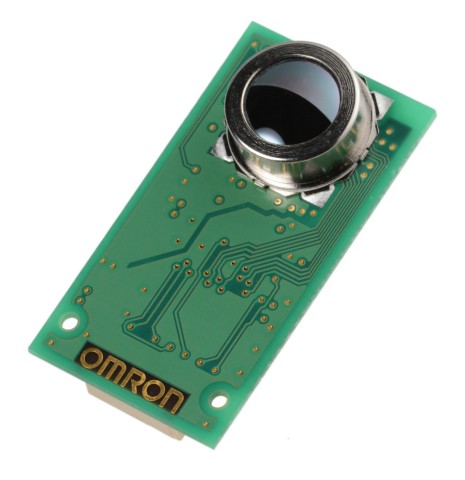TOKYO--(BUSINESS WIRE)--OMRON Corporation (TOKYO:6645)(ADR:OMRNY) today announced that they have finished development work on the world's first infrared sensor manufactured with wafer-level vacuum packaging technology to create a 16x16 element MEMS non-contact infrared thermal sensor capable of highly precise 90-degree area detection. Shipping of test samples will commence in October 2013.
In recent years the demand for human presence sensors has been growing
in tandem with the demand for energy-efficient "smart home" and "smart
office" environments in which lighting, heating, etc. is automatically
controlled according to where people are positioned.
Since
conventional pyroelectric human presence sensors (motion sensors) are
only able to detect people when they are in motion, they are not as
suitable for detecting the number of people in a certain space or their
relative positions as Omron's new thermal sensor.
MEMS non-contact thermal sensors measure temperature by converting
infrared energy radiated from target objects into heat with MEMS
thermopiles and then measuring the thermoelectromotive force resulting
from temperature differences that occur across the contact points of two
different types of metal. However, up till now it has not been possible
to create large temperature differences across the metal contact points
because much of the heat generated by the thermopiles dissipates into
the surrounding air, meaning that the resulting thermoelectromotive
force is reduced thereby limiting sensitivity. Omron has solved this
heat dissipation problem by vacuum sealing the thermopiles inside the
chip – the first time this has been achieved. The reduction in heat
dissipation leads to a greater temperature difference across the metal
contacts thereby increasing sensitivity.
Omron will now also work
on commercializing stand-alone human presence sensor modules by
combining non-contact thermal sensors with algorithms that can
accurately distinguish the number of people and their positions within a
detected space.
Model versions of Omron's new human presence sensors will be displayed at the "Nanomicro Biz" Exhibition at Tokyo Big Sight on July 3, 4, and 5.
The development of this new sensor was the result of research carried out in collaboration with Japan's New Energy and Industrial Technology Development Organization.
* As of May 29, 2013, according to Omron's own research on MEMS non-contact thermal sensors.
Features
- The ability to detect motionless people thanks to
the use of thermopile-based sensors, unlike pyroelectric sensors that
can only detect people when they are moving.
- Improved accuracy of detection of people's positions within the target space with thermal sensing possible over a two-dimensional 256 pixel (16x16 element) area.
- Wide 90-degree field of view means that one sensor can be used to cover a space that would require four 45-degree sensors to cover.
- High-speed 4fps (4 frame per second) detection makes it possible to detect people moving at 1m/s.
|
Specifications/Performance |
||
| Number of elements | 16x16 | |
| Detectable target temperature range | 5-50 degrees Celsius | |
| Field of view | 90 degrees minimum | |
| Power supply voltage | DC2.7 to 5.5V | |
| Data transmission | SPI | |
| Temperature resolution (NETD) | 0.15 degrees Celsius | |
| External dimensions | W 20mm×L 37mm×H 10.7mm | |
Release date: October 2013 (test samples)
Sales target: 2 billion JPY in fiscal 2015
How non-contact thermal sensors work
Thermal sensors utilize the Seebeck effect in which thermoelectric force is generated due to the temperature difference at the contact points between two different kinds of metal. Thermopiles are created by serially connecting thermocouples consisting of N+ poly Si, P+ poly Si, and Al. By creating hot junctions on highly heat-resistant dielectric membranes, and cold junctions on highly heat-conductive silicon, it is possible to achieve high-energy conversion efficiency. Sealing thermopiles in a vacuum prevents the heat they create from dissipating into the air thereby increasing sensitivity. For a diagram explaining the new vacuum-sealed design click here: http://www.omron.com/media/press/2013/05/img/e0529_b.jpg
About OMRON
Headquartered in Kyoto, Japan, OMRON Corporation
is a global leader in the field of automation. Established in 1933,
Omron has more than 35,000 employees in over 35 countries working to
provide products and services to customers in a variety of fields
including industrial automation, electronic components, social systems,
healthcare, and the environment. The company has regional head offices
in Singapore (Asia Pacific), Beijing (Greater China), Amsterdam (Europe,
Africa, and the Middle East), Chicago (the Americas), Gurgaon (India),
and Sao Paulo (Brazil).
For more information, visit OMRON's website
at http://www.omron.com/




